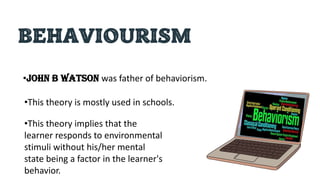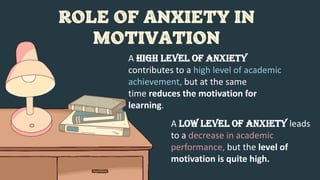motivation.pdf
- 1. Motivation Presented to: Ms.Rashida Arif Presented by: Alisha Aslam (bsf2101191) Sara Munir (bsf2101013) Zainab Azeem (Bsf2100871)
- 2. PRESENTATION OUTLINE INTRODUCTION TYPES OF MOTIVATION THEORIES OF MOTIVATION STRATEGIES TO MOTIVATE STUDENTS PRINCIPLES OF MOTIVATION
- 3. INTRODUCTION . Motivation is derived from Latin word " movere“ which means "to move "
- 5. MOTIVATION: "Motivation can be defined as a stimulating and inspiring a person to their best capacity" •Motivation is a kind of internal energy which drives a person to do something •It’s the reason of people’s willingness, actions and goals
- 6. What is motivation? Motivation …. A need that requires satisfaction. These needs could also be wants or desires that are required are through influence of culture , society and lifestyle etc FACTORS OR ASPECTS OF MOTIVATION •Need •Drive •Incentives •Effect
- 7. MOTIVATION Motivation is defined as the reasons why you are doing something, or the level of desire you have to do something EXAMPLE: If you want to lose weight to get healthier, this is an example of motivation to improve your health.
- 8. What is motivation? Motivation …. Activates (Gets you going) Maintains (keeps you going) Guides (determine where you are trying to go)
- 9. TYPES OF MOTIVATION: 1. INTRINSIC MOTIVATION 2. EXTRINSIC MOTIATION
- 10. INTRINSIC MOTIVATION EXTRINSIC MOTIVATION Type of motivation in which an individual is being motivated by internal desires. Type of motivation in which an individual is being motivated by external desires. Participating in a sport because it's fun and you enjoy it rather than doing it to win an award Being paid to do a job. EXAMPLE
- 11. PRINCIPLES OF MOTIVATION 1. INTRINSIC MOTIVATION 2. EXTRINSIC MOTIATION Following are the principles of motivation: •To have some choice and control •To feel connected •Relevance to interests and goals •To master a domain or compare •Emotionally involved •Control on success and failure
- 12. Principles of motivation EXAMPLE 1. Students are more likely to be intrinsically motivated when they expect to succeed and believe that they have some choice and control. allowing students to choose their own research topic instead of assigning it to them
- 13. PRINCIPLES OF MOTIVATION 2.Students need to feel connected with others. Example: It is hard to feel motivated to do much of anything if you feel like an outsider in a classroom community
- 14. PRONCIPLES OF MOTIVATION 3. Students are more likely to pursue an activity when they see its relevance to their own interests and goals. EXAMPLE: answering the age-old question, "when am I ever going to need to know this?"
- 15. PRINCIPLES OF MOTIVATION 4. Students who truly want to master a domain are more likely to learn effectively than those who are mainly concerned with how they appear or how they compare with others. EXAMPLE: the time you learned something just for the sake of learning it versus the time that you "learned" course material just to get a passing grad
- 16. PRINCIPLES OF MOTIVATION: 5. Students who are emotionally involved in a topic usually learn and remember it better, but high levels of anxiety can be detrimental. EXAMPLE: have you ever over-studied and been too anxious or stressed when taking a test and then ended up failing it?
- 17. PRINCIPLES OF MOTIVATION 6.Students are most likely to put forth effort when they attribute successes and failures to factors over which they have control. EXAMPLE: knowing that you have passed or failed a test due entirely to the amount or effort you put in
- 18. THEORIES OF MOTIVATION: 1_Behaviorism (It's back !) 2_Maslow's Hierarchy of needs 3_Attribution Theory 4_Expectancy Theory 5_Goals Orientation 6_The Flow Model
- 19. BEHAVIOURISM •John B Watson was father of behaviorism. •This theory is mostly used in schools. •This theory implies that the learner responds to environmental stimuli without his/her mental state being a factor in the learner's behavior.
- 20. According to behaviorism VIEW OF LEARNING; “when children are rewarded with praise and a gold star for doing their job correctly , they will look forward to the next lesson , anticipating another reward” EXAMPLE you might be motivated to go to work each day for the monetary reward of being paid.
- 21. Maslow's Hierarchy of needs •This theory proposed by Abraham Maslow in 1943. •According to him ,five stages of human needs motivate their behavior. • Being a hierarchy , the needs at the bottom of triangle must be met before you can move up to the next level • The purpose of this theory is to study behavior
- 23. ATTRIBUTION THEORY • First proposed by Fritz Heider in 1958 Attribution theory states that • people try to determine why people do what they do , that is to say , try to find out casual relationships between events and •behaviors . •Based on many criteria , including "locus of control"( which can be internal or external)
- 24. EXAMPLE: Maria's car breaks down on the freeway. If she believes the breakdown happened because of her ignorance about cars, she is making an internal attribution. If she believes that the breakdown happened because her car is old, she is making an external attribution.
- 26. EXPECTANCY THEORY •First proposed by Victor Vroom •According to this theory “Motivation depends upon person's estimation of their chance for success and how much value they place on that achievement”
- 27. EXAMPLE: An example of expectancy is thinking ; “ If I work hard I can achieve the targets my boss has set for me”
- 28. Add a personal touch by customizing this layout as much as you want.
- 29. GOALS ORIENTATION •In early 1960's Edwin Locke proposed a Goals Orientation theory of Motivation •This theory states that “the goal orientation is essentially based on the performance of the task”
- 30. According to Carol Dweck , students are oriented toward one of two kinds of goals in a learning situation. Performance goals: “student is motivated by the desire to gain recognition from others and earn good grades” Learning goals: “ student is motivated by desire for knowledge acquisition and self improvement”
- 32. THE FLOW MODEL 1. INTRINSIC MOTIVATION 2. EXTRINSIC MOTIATION •Originated by: Mihaly Csikszentmihalyi •Orignated in 1990
- 33. Flow theory proposes that when one is actively engaged in an activity where the skills possessed are balanced to the challenge of the activity, she/he can approach an optimal state of experience called “flow”
- 34. Strategies to motivate students Top 5 Strategies for Motivating Students i. Promote growth mindset over fixed mindset. ii. Develop meaningful and respectful relationships with your students iii. Grow a community of learners in your classroom. iv. Establish high expectations and establish clear goals v. Be inspirational.
- 35. TEACHERS ROLE IN CREATING CLASSROOM ENVIRONMENT • Supports student learning environment • They often do this through their support for students' autonomy. • By supporting students' choices student’s interests • teachers help students develop personal interest, involvement, and ownership of their work, which aid in motivation.
- 36. TEACHER’S ROLE IN MOTIVATION: For knowing teacher’s role in motivation , we will look at; •The ARCS model •Extrinsic and intrinsic motivators • Anxiety •Teacher expectation
- 37. The arcs model ARSC stands for attention ,Relevance, Confidence and Satisfaction 1.ATTENTION: It refers to learner’s interest 2.RELevance: It’s critical to get and hold the learners' interests and attention 3.Confidence: focuses on developing success expectation among learners 4.Satisfaction : Learners should be satisfied of what they achieved during the learning process
- 38. Extrinsic and intrinsic motivators Extrinsic motivators learn for the sake of getting rewards Intrinsic motivators learn for the leaning’s sake
- 39. ROLE OF ANXIETY IN MOTIVATION A high level of anxiety contributes to a high level of academic achievement, but at the same time reduces the motivation for learning. A low level of anxiety leads to a decrease in academic performance, but the level of motivation is quite high.
- 40. MOTIVATION CURVE A little bit is good , too much or not enough is bad
- 41. ROLE OF TEACHERS EXPECTATIONS •Teachers expectations play a HUGE role •Student will only give what you expect from them If you expect less , you will get less Similarly , If you expect more and boost up their abilities you will get more
- 42. THANK YOU FOR LISTENING! Don't hesitate to ask any questions!









































